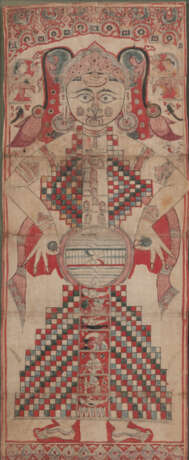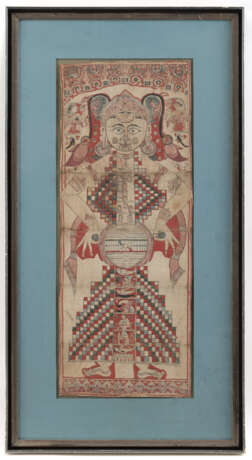ID 972875
Lot 1834 | Das jainistische Universum in menschlicher Gestalt (lokapuruṣa)
Estimate value
€ 1 500 – 2 500
84 x 28 cm R.
Das jainistische Universum ist bereits in der frühen Überlieferung der Jainas ausführlich beschrieben und wurde vor allem im 16. und 17. Jahrhundert zu einem wichtigen Thema der jainistischen Literatur. Gleichzeitig wurde das Universum auch zu einem Motiv der jainistischen Kunst. Neben Miniaturen, die zur Illustration in kosmologischen Handschriften gefertigt wurden, entstanden großformatige Stoffbilder, die den Kosmos meist in Gestalt eines ‚Weltmenschen‘ (Sanskrit: lokapuruṣa) zeigten. Im Umriss ähnelt das jainistische Universum einer Sanduhr, die in der Malerei den Ober- und Unterleib des kosmischen Mannes bilden und aus einer Vielzahl farbiger Quadrate zusammengesetzt ist, womit die verschiedenen Ebenen der Himmel und Höllen angedeutet werden. Im unteren Abschnitt, der sich hüftabwärts des lokapuruṣa erstreckt, sind die sieben Ebenen der Höllen und die Höllenqualen abgebildet. Den Oberkörper bilden die übereinander gelagerten Ebenen der Himmel, die sich bis in das Gesicht des ‚Weltmenschen‘ erstrecken und durch die Abbildungen der himmlischen Könige, die Herrscher der Himmelgegenden, gekennzeichnet sind. Eine kreisrunde Scheibe in der Hüftgegend des lokapuruṣa zeigt den Zentralkontinent Jambudvīpa als Ausschnitt der mittleren Welt (madhyaloka), die von Menschen und Tieren bewohnt wird. Auf der Stirn markiert eine liegende Mondsichel den paradiesischen Ort am Scheitelpunkt des Universums, an dem sich die Jinas nach ihrer Erlösung aufhalten. Die Abbildung des ‚Weltenmannes‘ ist an Darstellungen des Jina in der frühneuzeitlichen Miniaturmalerei (sog. Westindischer Stil) angelehnt. Dies zeigt sich in der Gestaltung von Gesichts und in der Krone, vor allem aber durch die Aśokabaumblüten, die an langen Stengeln herabhängen und den Kopf nimbusartig einfassen. Den Kopf des ‚Weltenmannes‘ flankierend stehen zwei Götter mit Krügen, wie sie zur Weihe der Jinas in den Miniaturen zur Jinalegende abgebildet werden. Ebenso wie der reichverzierte Baldachin am oberen Bildrand und der bordürenartig gestaltete Sockel ähneln diese göttlichen Wesen entsprechenden Abbildungen in der jainistische Miniaturmalerei und rücken die Stoffmalerei stilistisch in die Nähe der westindischen Malschulen.
| Address of auction |
Nagel Auktionen GmbH Neckarstrasse 189 - 191 70190 Stuttgart Germany | ||||||||||||||
|---|---|---|---|---|---|---|---|---|---|---|---|---|---|---|---|
| Preview |
| ||||||||||||||
| Phone | +49 (0)711 649 690 | ||||||||||||||
| Fax | +49 (0)711 649 69696 | ||||||||||||||
| Buyer Premium | 29,5% | ||||||||||||||
| Conditions of purchase | Conditions of purchase | ||||||||||||||
| Business hours | Business hours
|




